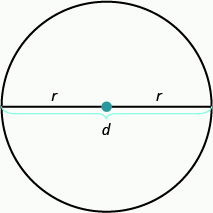Properties of Circles

[latex-display]\begin{array}{c}r\text{ is the length of the radius.}\hfill \\ d\text{ is the length of the diameter.}\hfill \end{array}[/latex-display]
[latex-display]\begin{array}{cccc}\text{The circumference is }2\pi \mathit{\text{r}}.\hfill & & & C=2\pi \mathit{\text{r}}\hfill \\ \text{The area is }\pi{\mathit{\text{r}}}^{2}.\hfill & & & A=\pi{\mathit{\text{r}}}^{2}\hfill \end{array}[/latex-display]
Since the diameter is twice the radius, another way to find the circumference is to use the formula [latex]C=\pi \mathit{\text{d}}[/latex].
Suppose we want to find the exact area of a circle of radius [latex]10[/latex] inches. To calculate the area, we would evaluate the formula for the area when [latex]r=10[/latex] inches and leave the answer in terms of [latex]\pi[/latex].
[latex-display]\begin{array}{}\\ A=\pi {\mathit{\text{r}}}^{2}\hfill \\ A=\pi \text{(}{10}^{2}\text{)}\hfill \\ A=\pi \cdot 100\hfill \end{array}[/latex-display]
We write [latex]\pi [/latex] after the [latex]100[/latex]. So the exact value of the area is [latex]A=100\pi [/latex] square inches.
To approximate the area, we would substitute [latex]\pi \approx 3.14[/latex].
[latex-display]\begin{array}{ccc}A& =& 100\pi \hfill \\ \\ & \approx & 100\cdot 3.14\hfill \\ & \approx & 314\text{ square inches}\hfill \end{array}[/latex-display]
Remember to use square units, such as square inches, when you calculate the area.
example
A circle has radius [latex]10[/latex] centimeters. Approximate its ⓐ circumference and ⓑ area.
Solution
| ⓐ Find the circumference when [latex]r=10[/latex]. |
|
| Write the formula for circumference. |
[latex]C=2\pi \mathit{\text{r}}[/latex] |
| Substitute [latex]3.14[/latex] for [latex]\pi [/latex] and 10 for , [latex]r[/latex] . |
[latex]C\approx 2\left(3.14\right)\left(10\right)[/latex] |
| Multiply. |
[latex]C\approx 62.8\text{ centimeters}[/latex] |
| ⓑ Find the area when [latex]r=10[/latex]. |
|
| Write the formula for area. |
[latex]A=\pi {\mathit{\text{r}}}^{2}[/latex] |
| Substitute [latex]3.14[/latex] for [latex]\pi [/latex] and 10 for [latex]r[/latex] . |
[latex]A\approx \left(3.14\right){\text{(}10\text{)}}^{2}[/latex] |
| Multiply. |
[latex]A\approx 314\text{ square centimeters}[/latex] |
example
A circle has radius [latex]42.5[/latex] centimeters. Approximate its ⓐ circumference and ⓑ area.
Answer:
Solution
| ⓐ Find the circumference when [latex]r[/latex]=[latex]42.5[/latex]. |
|
| Write the formula for circumference. |
[latex]C=2\pi \mathit{\text{r}}[/latex] |
| Substitute [latex]3.14[/latex] for [latex]\pi [/latex] and [latex]42.5[/latex] for [latex]r[/latex] |
[latex]C\approx 2\left(3.14\right)\left(42.5\right)[/latex] |
| Multiply. |
[latex]C\approx 266.9\text{ centimeters}[/latex] |
| ⓑ Find the area when [latex]r=42.5[/latex] . |
|
| Write the formula for area. |
[latex]A=\pi {\mathit{\text{r}}}^{2}[/latex] |
| Substitute [latex]3.14[/latex] for [latex]\pi [/latex] and [latex]42.5[/latex] for [latex]r[/latex] . |
[latex]A\approx \left(3.14\right){\text{(}42.5\text{)}}^{2}[/latex] |
| Multiply. |
[latex]A\approx 5671.625\text{ square centimeters}[/latex] |
example
A circle has radius [latex]\frac{14}{15}[/latex] meter. Approximate its ⓐ circumference and ⓑ area.
Answer:
Solution
| ⓐ Find the circumference when [latex]r=\frac{14}{15}[/latex]. |
|
| Write the formula for circumference. |
[latex]C=2\pi \mathit{\text{r}}[/latex] |
| Substitute [latex]\frac{22}{7}[/latex] for [latex]\pi [/latex] and [latex]\frac{14}{15}[/latex] for [latex]r[/latex] . |
[latex]C\approx 2\left(\frac{22}{7}\right)\left(\frac{14}{15}\right)[/latex] |
| Multiply. |
[latex]C\approx \frac{88}{15}\text{meters}[/latex] |
| ⓑ Find the area when [latex]r=\frac{14}{15}[/latex]. |
|
| Write the formula for area. |
[latex]A=\pi {\mathit{\text{r}}}^{2}[/latex] |
| Substitute [latex]\frac{22}{7}[/latex] for [latex]\pi [/latex] and [latex]\frac{14}{15}[/latex] for [latex]r[/latex] . |
[latex]A\approx \left(\frac{22}{7}\right){\text{(}\frac{14}{15}\text{)}}^{2}[/latex] |
| Multiply. |
[latex]A\approx \frac{616}{225}\text{square meters}[/latex] |
 Archimedes discovered that for circles of all different sizes, dividing the circumference by the diameter always gives the same number. The value of this number is pi, symbolized by Greek letter [latex]\pi [/latex] (pronounced "pie"). However, the exact value of [latex]\pi [/latex] cannot be calculated since the decimal never ends or repeats (we will learn more about numbers like this in The Properties of Real Numbers.)
Doing the Manipulative Mathematics activity Pi Lab will help you develop a better understanding of pi.
If we want the exact circumference or area of a circle, we leave the symbol [latex]\pi [/latex] in the answer. We can get an approximate answer by substituting [latex]3.14[/latex] as the value of [latex]\pi [/latex]. We use the symbol [latex]\approx [/latex] to show that the result is approximate, not exact.
Archimedes discovered that for circles of all different sizes, dividing the circumference by the diameter always gives the same number. The value of this number is pi, symbolized by Greek letter [latex]\pi [/latex] (pronounced "pie"). However, the exact value of [latex]\pi [/latex] cannot be calculated since the decimal never ends or repeats (we will learn more about numbers like this in The Properties of Real Numbers.)
Doing the Manipulative Mathematics activity Pi Lab will help you develop a better understanding of pi.
If we want the exact circumference or area of a circle, we leave the symbol [latex]\pi [/latex] in the answer. We can get an approximate answer by substituting [latex]3.14[/latex] as the value of [latex]\pi [/latex]. We use the symbol [latex]\approx [/latex] to show that the result is approximate, not exact.
 [latex-display]\begin{array}{c}r\text{ is the length of the radius.}\hfill \\ d\text{ is the length of the diameter.}\hfill \end{array}[/latex-display]
[latex-display]\begin{array}{cccc}\text{The circumference is }2\pi \mathit{\text{r}}.\hfill & & & C=2\pi \mathit{\text{r}}\hfill \\ \text{The area is }\pi{\mathit{\text{r}}}^{2}.\hfill & & & A=\pi{\mathit{\text{r}}}^{2}\hfill \end{array}[/latex-display]
[latex-display]\begin{array}{c}r\text{ is the length of the radius.}\hfill \\ d\text{ is the length of the diameter.}\hfill \end{array}[/latex-display]
[latex-display]\begin{array}{cccc}\text{The circumference is }2\pi \mathit{\text{r}}.\hfill & & & C=2\pi \mathit{\text{r}}\hfill \\ \text{The area is }\pi{\mathit{\text{r}}}^{2}.\hfill & & & A=\pi{\mathit{\text{r}}}^{2}\hfill \end{array}[/latex-display]
